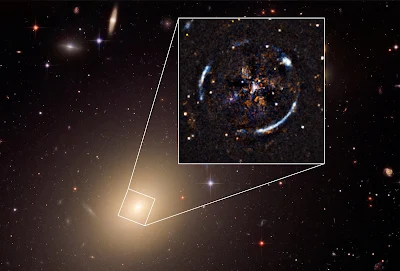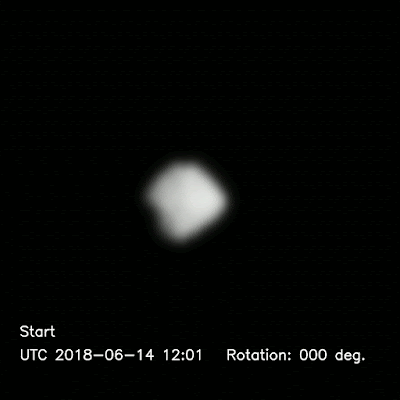Ο
πιο ακριβής έως σήμερα έλεγχος της γενικής θεωρίας σχετικότητας του Αϊνστάιν. An image
of the nearby galaxy ESO 325-G004, created using data collected by the NASA/ESA
Hubble Space Telescope and the MUSE instrument on the ESO’ Very Large
Telescope. MUSE measured the velocity of stars in ESO 325-G004 to produce the
velocity dispersion map that is overlaid on top of the Hubble Space Telescope
image. Knowledge of the velocities of the stars allowed the astronomers to
infer the mass of ESO 325-G004. The inset shows the Einstein ring resulting
from the distortion of light from a more distant source by intervening lens ESO
325-004, which becomes visible after subtraction of the foreground lens light. Credit: ESO,
ESA/Hubble, NASA
Μια
διεθνής ομάδα αστρονόμων έκανε τον πιο ακριβή έως σήμερα έλεγχο της γενικής
θεωρίας σχετικότητας του Αϊνστάιν όχι μόνο πέρα από το ηλιακό μας σύστημα, αλλά
και πέρα από τον δικό μας γαλαξία, επιβεβαιώνοντας την ορθότητά της, για τη
συμπεριφορά της βαρύτητας σε κοσμική κλίμακα.
Astronomers have
made the most precise test ever of general relativity outside the Milky Way. A
nearby galaxy acts as a strong gravitational lens, distorting light from a
distant galaxy behind it to create an Einstein ring around its centre. By
comparing the mass of the lensing galaxy with the curvature of space around it,
the astronomers found that gravity on these astronomical length-scales behaves
as predicted by general relativity. Credit: ESO
Συνδυάζοντας
στοιχεία από το διαστημικό τηλεσκόπιο «Χαμπλ» και το Πολύ Μεγάλο Τηλεσκόπιο του
Ευρωπαϊκού Νοτίου Αστεροσκοπείου στη Χιλή, οι επιστήμονες έδειξαν ότι πράγματι
η βαρύτητα συμπεριφέρεται όπως ακριβώς προβλέπει η γενική θεωρία σχετικότητας
που είχε παρουσιάσει ο Άλμπερτ Αϊνστάιν το 1915.
This infographic
compares the two methods used to measure the mass of the galaxy ESO 325-G004.
The first method used ESO’s Very Large Telescope to measure the velocities of
stars in ESO 325-G004. The second method used the NASA/ESA Hubble Space
Telescope to observe an Einstein ring caused by light from a background galaxy
being bent and distorted by ESO 325-G004. By comparing these two methods of
measuring the strength of the gravity of ESO 325-G004, it was determined that
Einstein’s general theory of relativity works on extragalactic scales —
something that had not been previously tested. Credit: ESA/Hubble,
ESO, NASA
Από τότε, η θεωρία αυτή έχει περάσει με «άριστα» από αλλεπάλληλα τεστ στη Γη και το διάστημα. Οι νέες ακόμη πιο μακρινές μετρήσεις, που έδειξαν πως καμπυλώνεται το φως (και άρα ο χωροχρόνος) γύρω από τον γαλαξία, επιβεβαίωσαν για μια ακόμη φορά ότι η θεωρία είναι σωστή.
Οι
ερευνητές από τη Βρετανία, τη Γερμανία και τις ΗΠΑ, με επικεφαλής τον δρα Τόμας
Κόλετ του Ινστιτούτου Κοσμολογίας και Βαρύτητας του βρετανικού Πανεπιστημίου
του Πόρτσμουθ, που έκαναν τη σχετική δημοσίευση στο περιοδικό "Science",
χρησιμοποίησαν έναν σχετικά κοντινό γαλαξία (τον ESO325-G004 σε απόσταση 450 εκατομμυρίων ετών φωτός
από τη Γη) ως βαρυτικό φακό για να πραγματοποιήσουν ένα τεστ ακριβείας της
θεωρίας.
This diagram shows
how the effect of gravitational lensing around a normal galaxy focuses the
light coming from a very distant star-forming galaxy merger to created a
distorted, but brighter view. The NASA/ESA Hubble Space Telescope and many
other telescopes on the ground and in space have enlisted the help of a
galaxy-sized magnifying glass to reveal otherwise invisible detail and obtain
the best view yet of a collision that took place between two galaxies when the
Universe was only half its current age. The image showing these combined
observations can be seen in the inset. These new studies of the galaxy H-ATLAS
J142935.3-002836 have shown that this complex and distant object looks
surprisingly like the well-known local galaxy collision, the Antennae Galaxies.
Credit: ESA/ESO/M. Kornmesser
Ο
γαλαξίας αυτός δρα ως ισχυρός βαρυτικός φακός, στρεβλώνοντας το φως από έναν
άλλο πολύ πιο μακρινό γαλαξία που βρίσκεται από πίσω του, δημιουργώντας έτσι
τον λεγόμενο φωτεινό «δακτύλιο Αϊνστάιν» γύρω από το κέντρο του. Συγκρίνοντας
τη μάζα του γαλαξία ESO
325-G004 με την καμπύλωση
του χώρου γύρω του, οι αστρονόμοι βρήκαν ότι η βαρύτητα συμπεριφέρεται σύμφωνα
με τις προβλέψεις της γενικής θεωρίας της σχετικότητας.
Thomas Collett
discusses the methods behind his research into whether Einstein’s general
theory of relativity is correct on extragalactic length scales. This research
was published in the journal, Science,
in June 2018. Credit:
University of Portsmouth
«Είναι τόσο ανακουφιστικό να
χρησιμοποιούμε τα καλύτερα τηλεσκόπια στον κόσμο για να θέσουμε σε αμφισβήτηση
τον Αϊνστάιν και τελικά να βρίσκουμε πόσο σωστός ήταν» δήλωσε ο καθηγητής Μπομπ Νίκολ,
διευθυντής του Ινστιτούτου Κοσμολογίας και Βαρύτητας.
This image from the
NASA/ESA Hubble Space Telescope shows the diverse collection of galaxies in the
cluster Abell S0740 that is over 450 million light-years away in the direction
of the constellation Centaurus. The giant elliptical ESO 325-G004 looms large
at the cluster's centre. Hubble resolves thousands of globular star clusters
orbiting ESO 325-G004. Globular clusters are compact groups of hundreds of
thousands of stars that are gravitationally bound together. At the galaxy's
distance they appear as pinpoints of light contained within the diffuse halo.
This image was created by combining Hubble science observations taken in
January 2005 with Hubble Heritage observations taken a year later to form a
3-colour composite. The filters that isolate blue, red and infrared light were
used with the Advanced Camera for Surveys aboard Hubble. Credit: NASA, ESA, and
The Hubble Heritage Team (STScI/AURA)
Το
νέο τεστ σχετίζεται και με την επέκταση του σύμπαντος, κάτι που είναι γνωστό
ήδη από το 1929 ότι συμβαίνει, αλλά το 1998 έγινε πλέον αντιληπτό ότι η
διαστολή του σύμπαντος είναι ταχύτερη σήμερα από ό,τι στο παρελθόν.
Αυτό
μπορεί να εξηγηθεί μόνο αν υπάρχει ένας «εξωτικός» παράγων διαστολής, η
λεγόμενη -και προς το παρόν μόνο θεωρητική- σκοτεινή ενέργεια. Όμως το κατά
πόσο μπορεί να ισχύει αυτή η εξήγηση της επιταχυνόμενης διαστολής του
σύμπαντος, εξαρτάται από το εάν ισχύει επίσης η γενική θεωρία.
Πηγές: Science
paper - https://www.spacetelescope.org/news/heic1812/
- http://www.tovima.gr/science/article/?aid=993946
















